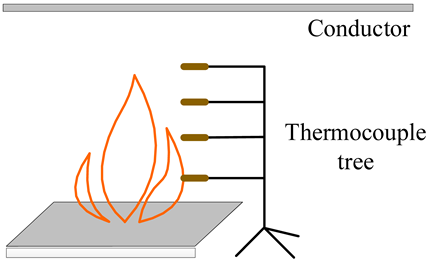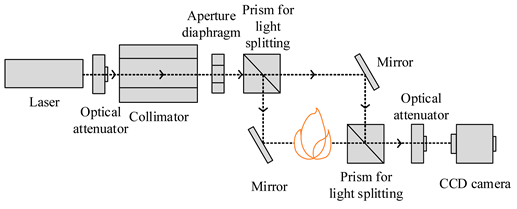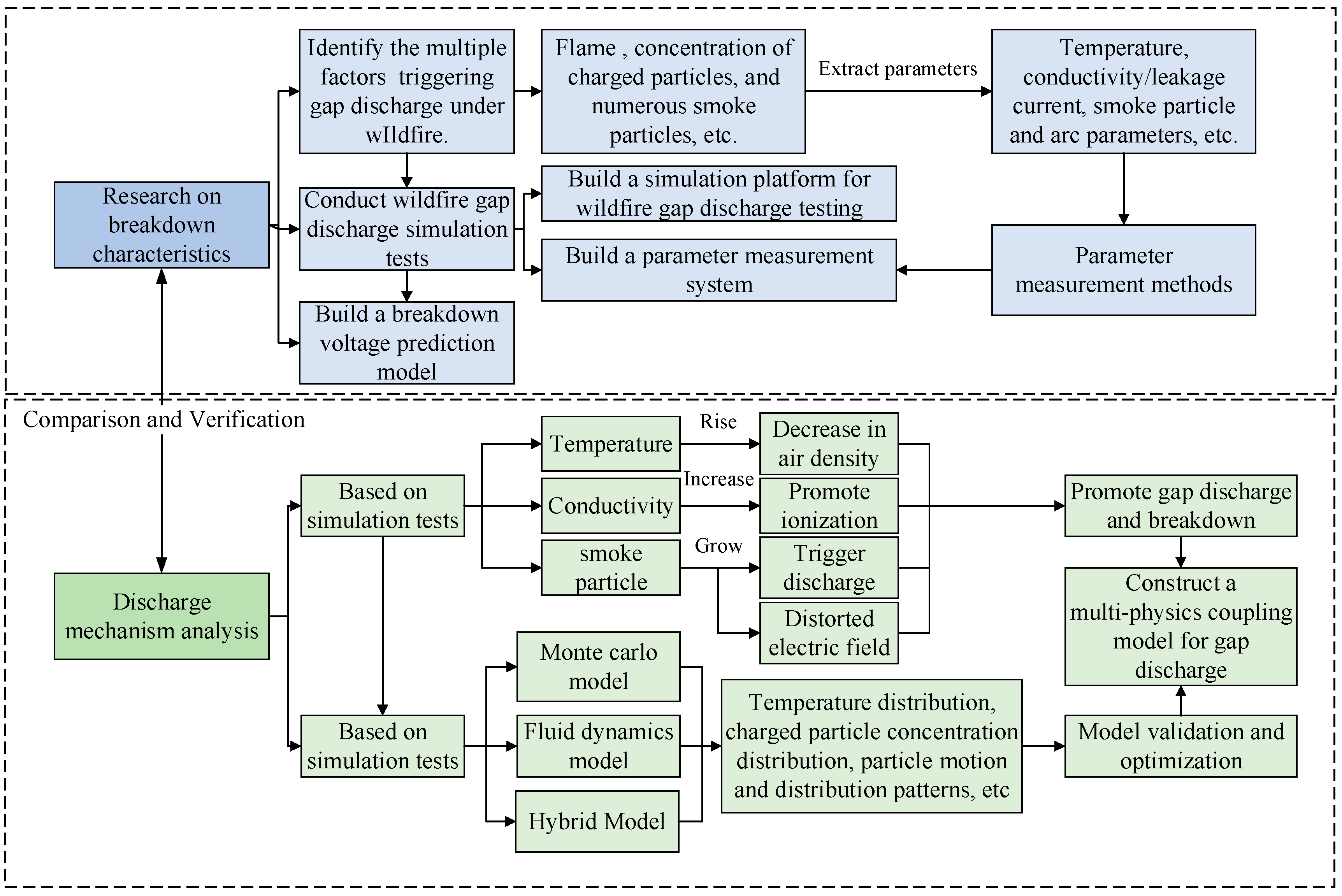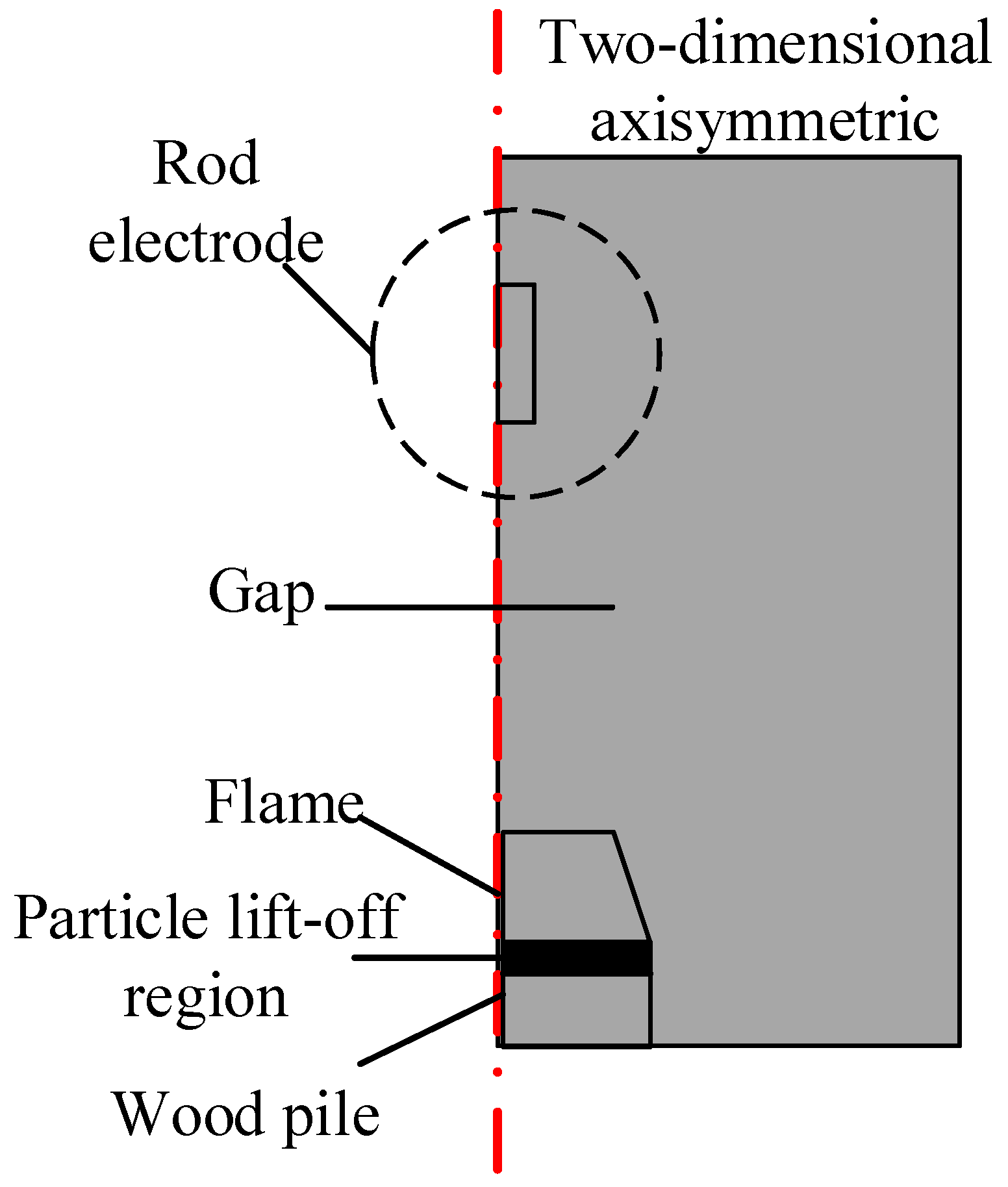The Progress and Prospect of Gap Breakdown Characteristics and Discharge Mechanisms of Overhead Transmission Lines Under Vegetation Fire Conditions
Abstract
1. Introduction
2. Materials and Methods
2.1. Research on Breakdown Characteristics
2.1.1. Analysis of the Factors Affecting Power Line Tripping Caused by Wildfires
2.1.2. Parameter Measurement Methods
- Temperature measurement
- 2.
- Conductivity Measurement
- 3.
- Smoke Particle Parameter Measurement
| Temperature Measurement | Principle | Structure | Advantages | Disadvantages | |
|---|---|---|---|---|---|
| Contact | Thermocouple, thermistor, and expansion thermometer [13] | Using temperature measurement elements in direct contact with the object to be measured, reaching thermal equilibrium. |  | Simple structure, easy to use, highly reliability, and can directly obtain the variation curve of flame temperature with time and height. | Interference with the measured flow field achieved, slow response speed, and not suitable for transient temperature measurement. |
| Non-contact | Acoustic method [14] | The propagation speed of sound waves in a medium is functionally related to its temperature and type. |  | The response speed has been improved. | Easily affected by dust, particulate matter, and airflow. |
| Infrared radiation [14] | Identifying and measuring the thermal radiation spectrum of an object. |  | Fast response speed, high resolution, and capable of providing 2D and 3D flame temperature distributions. | Unable to provide dynamic monitoring of the measured object and work in rainy conditions. | |
| Holographic interference [15,16] | Using light interference passing through the measured medium, the temperature distribution is obtained by processing recorded light information. |  | Suitable for quantitative and qualitative measurements of dynamic objects in real-time measurement. | Includes optical instruments with complex experimental setups for measuring 3D turbulent flames. | |
- 4.
- Arc Parameter Measurement
3. Results
3.1. Breakdown Characteristic Experiments
3.2. Breakdown Voltage Prediction Model
3.3. Discharge Mechanism Analysis
3.3.1. Mechanism Analysis Based on Simulated Experiments
- Flame Temperature
- 2.
- Conductivity
- 3.
- Smoke Particles
3.3.2. Mechanism Analysis Based on Numerical Simulation
- Particle-in-Cell/Monte Carlo Collision (PIC/MCC) Model
- 2.
- Fluid Dynamics Model
- 3.
- Hybrid Model
4. Discussion
5. Conclusions
Funding
Conflicts of Interest
References
- He, C.; Shu, L. Study on Environmental Characteristics of High Voltage Line Trip Caused by Mountain Fire in Guangxi Region. Fire Sci. Technol. 2020, 39, 1626–1629. [Google Scholar]
- Zhou, E.; Gong, B. Statistics and Analysis on Tripping Fault of Overhead Transmission Lines Caused by Mountain Fires in China Southern Power Grids. Guangdong Electr. Power 2022, 35, 80–86. [Google Scholar]
- Zhou, Z. Research on Risk Assessment of Power Grid Transmission-Line Trips Due to Wildfire Disasters; North China Electric Power University: Beijing, China, 2019. [Google Scholar] [CrossRef]
- Li, P.; Ruan, J. Influence Factors Analysis of the Conductor-Plane Gap Breakdown Characteristic Under Simulation Forest Fire Condition. Trans. China Electrotech. Soc. 2018, 33, 195–201. [Google Scholar] [CrossRef]
- Long, M.; Huang, D. Influence of the Typical Vegetation Ashes/Particles on the Discharge Characteristics of Conductor-Plane Air Gap. Trans. China Electrotech. Soc. 2018, 33, 627–633. [Google Scholar] [CrossRef]
- Zhou, E.; Fan, L. Breakdown Characteristics of Conductor-plane Gap Under Vegetation Fire at the Altitude of 2013 m. High Volt. Eng. 2022, 48, 4316–4322. [Google Scholar] [CrossRef]
- Lu, W. Simulated Experimental Study on the Breakdown Characteristics of the Gap with High-Risk Vegetation Flame. Master’s Thesis, Wuhan University, Wuhan, China, May 2019. [Google Scholar]
- Wu, M. The Evolution of Gas Laser Al Plasma in the Background Interference Diagnosis Research. Master’s Thesis, Northwest Normal University, Lanzhou, China, May 2023. [Google Scholar] [CrossRef]
- Yang, N.; Yang, B. Experimental Research on Impact of Mountain Fire Smoke on Insulation of 10~35 kV Transmission Lines. Sichuan Electr. Power Technol. 2022, 45, 6–9. [Google Scholar] [CrossRef]
- Hu, C. Research on External Insulation Characteristics And Laser Lidar Monitoring System of Forest Fire in Transmission Line. Master’s Thesis, South China University of Technology, Guangzhou, China, 2016. [Google Scholar]
- Liu, X. Study on Smoke Concentration Measurement by Pulse Laser. Master’s Thesis, Beijing Institute of Technology, Beijing, China, January 2016. [Google Scholar]
- Wang, Z. Research on the Distribution Law of Charged Particles in the Insulation Gap and the Characteristic of Synthetic Electric Field Distortion under Mountain Fire. Master’s Thesis, China Three Gorges University, Yichang, China, May 2022. [Google Scholar]
- Ma, Q.; Zhang, R.; Wang, W. Research on Effect of Single Thermocouple’s Placement on Temperature Calibration for Fire Test. In Proceedings of the 2020 IEEE 2nd International Conference on Civil Aviation Safety and Information Technology, Weihai, China, 14–16 October 2020; pp. 996–1003. [Google Scholar] [CrossRef]
- Chen, Y.; Zhang, H. Two-dimensional temperature field measurement by laser interference based on fringes Fourier transformation. J. Univ. Sci. Technol. China 2020, 50, 832–838. [Google Scholar]
- Sun, Z. Research on Flame Temperature Based on Laser Interferometry. Master’s Thesis, North China Electric Power University, Beijing, China, April 2020. [Google Scholar] [CrossRef]
- Lin, T.; Deng, Y. Flame Temperature Measurement Based on Atomic Spectroscopy. J. Instrum. Anal. 2021, 40, 785–789. [Google Scholar]
- Jiang, W. Impacts of Forest Fire on Streamer Discharge of Transmission Line GAP. Master’s Thesis, Hunan University, Changsha, China, April 2019. [Google Scholar] [CrossRef]
- Grange, F.; Soulem, N. Numerical and Experimental Determination of Ionizing Front Velocity in a DC Point-to-Plane Corona Discharge. J. Phys. D Appl. Phys. 1995, 28, 1619. [Google Scholar]
- Sigmond, R.S. The Residual Streamer Channel: Return Strokes and Secondary Streamers. J. Appl. Phys. 1984, 56, 1355–1370. [Google Scholar]
- He, H.; He, J. On the Positive upward Leader in Response to Downward Stepped Leader in a 10 m Rod-to-Rod Long Air Gap. In Proceedings of the International Conference on Lightning Protection, New York, NY, USA, 25–30 September 2016. [Google Scholar] [CrossRef]
- Hidaka, K.; Fujita, H. A New Method of Electric Field Measurements in Corona Discharge Using Pockels Device. J. Appl. Phys. 1982, 53, 5999–6003. [Google Scholar] [CrossRef]
- Zeng, R.; Zhuang, C. Electric Field Step in Air Gap Streamer Discharges. Appl. Phys. Lett. 2011, 99, 221503. [Google Scholar] [CrossRef]
- Zeng, R.; Wang, B. Design and Application of an Integrated Electro-optic Sensor for Intensive Electric Field Measurement. IEEE Trans. Dielectr. Electr. Insul. 2011, 18, 312–319. [Google Scholar] [CrossRef]
- Chun, K.; Song, D.; Kim, K. Study on the Decrease in Air Dielectric Strength of DC Voltage According to the Ignition Properties of Combustibles. Appl. Sci. 2022, 12, 2216. [Google Scholar] [CrossRef]
- Ntshangase, Z.; Swanson, A.; Ijumba, N.M.; Britten, A.C. An Empirical Model of Fire-Induced Airgap Voltage Breakdown Characteristics Under HVDC Conditions. In Proceedings of the 2017 IEEE AFRICON: Science, Technology, and Innovation for Africa, Cape Town, South Africa, 18–20 September 2017; pp. 1283–1289. [Google Scholar]
- Robledo-Martinez, A.; Guzman, E.; Hernandez, J.L. Dielectric Characteristics of a Model Transmission Line in the Presence of Fire. IEEE Trans. Electr. Insul. 1991, 26, 776–782. [Google Scholar] [CrossRef]
- Fonseca, J.R.; Tan, A.L. Effects of Agricultural Fires on the Performance of Overhead Transmission Lines. IEEE Trans. Power Deliv. 1990, 5, 687–694. [Google Scholar] [CrossRef]
- Moreno, M. Performance of External Insulation in Presence of Flames Due to Sugar Cane Burning; CIGRE: Paris, France, 1985; CIGRE WG 33-07/10 IWD. [Google Scholar]
- Lanoie, R.; Mercure, H. Influence of Forest Fires on Power Line Insulation. In Proceedings of the 6th International Symposium on High Voltage Engineering (ISH), Xi’an, China, 21–26 November 2021; pp. 12–18. [Google Scholar]
- Huang, D.; Lu, W.; Yao, T.; Xia, J.; Quan, W. Study on Leakage Current Characteristics of Conductor-Plane Short Air Gap Under Vegetation Fire Condition. J. Electr. Eng. Technol. 2019, 34, 3487–3493. [Google Scholar] [CrossRef]
- Huang, D.; Lu, W. Influence of Typical Vegetation Ashes on DC Breakdown Characteristics of Conductor-Plane Air Gap. Power Syst. Technol. 2018, 42, 1668–1674. [Google Scholar] [CrossRef]
- Huang, D.; Chen, X. Breakdown Voltage of Conductor-Plane Gap Under Vegetation Fire Condition Considering Division of Flames. Power Syst. Technol. 2023, 47, 3467–3474. [Google Scholar] [CrossRef]
- Huang, D.; Zhou, S. ACAC Breakdown Characteristics of Overhead Transmission Line Phase-Ground Long Air Gap Under Vegetation Fire Conditions. Proc. CSEE 2024, 7, 373. [Google Scholar] [CrossRef]
- Li, P.; Ruan, J. Study on Breakdown Characteristic and Discharge Model of Conductor-Plane Gap Under Typical Vegetation Flame. Proc. CSEE 2016, 36, 4001–4011. [Google Scholar] [CrossRef]
- Yang, K. Simulative Experimental and Numerical Study of Wildfire Induced Breakdown of Transmission Lines. Master’s Thesis, University of Science and Technology of China, Hefei, China, May 2016. [Google Scholar]
- Zhou, E.; Rao, Z.; Liu, Q.; Huang, Y.; Xiang, Z.; Wang, H.; Huang, D. Breakdown Characteristics of Conductor-Plane Gap Under Typical High Risk Vegetation Fire Condition. High Volt. Appar. 2024, 60, 179–185. [Google Scholar] [CrossRef]
- Chen, X.; Wei, H. Study on the Influence of Flame Height on Gap Breakdown Characteristics of Transmission Lines. Electr. Power 2015, 48, 134–138. [Google Scholar]
- Wang, T.; Zhou, E. Influence Factor Analysis of Conductor-Plane Gap Breakdown Characteristic Under Vegetation Fire at High Altitude Condition. Guangdong Electr. Power 2024, 37, 70–76. [Google Scholar]
- Liu, H.; He, Z. Research of electric field characteristics of high-voltage overhead transmission lines adjacent to trees. Zhejiang Electr. Power 2023, 42, 70–78. [Google Scholar] [CrossRef]
- Wang, D.; Lu, T. Modelling and Characteristic Research of Total Electric Field Around Trees Near ±1100 kV UHVDC Transmission Lines. Power Syst. Technol. 2017, 41, 3441–3447. [Google Scholar] [CrossRef]
- Shu, S.; Liu, C.; Ruan, J. Review on Prediction Methods for Breakdown Voltage of Air Gap. High Volt. Appar. 2016, 52, 19–26+32. [Google Scholar] [CrossRef]
- Khan, I.; Ghassemi, M. A Probabilistic Approach for Analysis of Line Outage Risk Caused by Wildfires. Int. J. Electr. Power Energy Syst. 2022, 139, 108042. [Google Scholar] [CrossRef]
- Song, J.; Guo, C.; Zhang, J.; Wang, Y.; Sheng, K. A Probabilistic Model of Overhead Transmission Line Outage due to Forest Fire. Power Syst. Technol. 2013, 37, 100–105. [Google Scholar] [CrossRef]
- Shao, Y.; Li, H.; Zhao, J.; Zou, J.; Zhou, X.; Chang, Q. Study and Analysis of Breakdown Probability Model of UHV Transmission Line under Forest Fire Conditions. Electr. Meas. Instrum. 2018, 55, 31–35+42. [Google Scholar]
- Zhou, C. Numerical Simulation Study on the Influence of Wildfire on Gap Discharge of Transmission Line. Master’s Thesis, Chongqing University, Chongqing, China, June 2021. [Google Scholar] [CrossRef]
- Yao, W. The Research on the Characteristics of the Two-Phase Mixture Discharges under the DC Voltage. Ph.D. Thesis, Huazhong University of Science and Technology, Wuhan, China, November 2013. [Google Scholar]
- Feng, J. Study on Gap Discharge Mechanism of Power Transmission and Distribution Lines Under Different Wildfire Conditions. Master’s Thesis, Xihua University, Chengdu, China, April 2023. [Google Scholar] [CrossRef]
- Huang, D.; Li, P. Review on Discharge Mechanism and Breakdown Characteristics of Transmission Line Gap Under Forest Fire Condition. High Volt. Eng. 2015, 41, 622–632. [Google Scholar] [CrossRef]
- You, F.; Chen, H. Experimental Study on Flashover of High-voltage Transmission Lines Induced by Wood Crib Fire. J. Proc. CSEE 2011, 31, 192–197. [Google Scholar] [CrossRef]
- Wang, Y.; Li, J.; Li, C. The effects of field-enhancement factor on the nanosecond pulsed breakdown of nitrogen spark switch at atmospheric pressure with 3D PIC-MCC model. In Proceedings of the 2024 IEEE International Conference on Plasma Science (ICOPS), Beijing, China, 16–20 June 2024; p. 1. [Google Scholar] [CrossRef]
- Chen, Z.; Liu, M.; Xia, G.; Huang, Y. PIC/MCC Simulation of the Ionization Process for Filamentary Streamer Plasma Jet at Atmosphere Pressure in Argon. IEEE Trans. Plasma Sci. 2012, 40, 2861–2865. [Google Scholar] [CrossRef]
- Babaeva, N.Y.; Kushner, M.J. Effect of Inhomogeneities on Streamer Propagation: I. Intersection with Isolated Bubbles and Particles. Plasma Sources Sci. Technol. 2009, 35, 035009. [Google Scholar]
- Peng, Q. Research of Plasma Chemical Model and Analysis of Influencing Factors of Streamer Discharge in Air. Ph.D. Thesis, Chongqing University, Chongqing, China, October 2012. [Google Scholar]
- Lin, B. Simulation Analysis on the Synergistic Effect of Vegetation Ashes and Charged Particles on the Gap Electric Field Distortion. J. Phys. D Appl. Phys. 2024, 57, 205501. [Google Scholar] [CrossRef]
- Hagelaar, G.J.M.; Pitchford, L.C. Solving the Boltzmann Equation to Obtain Electron Transport Coefficients and Rate Coefficients for Fluid Models. Plasma Sources Sci. Technol. 2005, 14, 722–733. [Google Scholar]
- Pu, Z.; Wang, Z. Motion and Distribution of Combustion Particles in Flame Gap Under DC Voltage. Trans. China Electrotech. Soc. 2020, 35, 612–619. [Google Scholar] [CrossRef]
- Pu, Z.; Sun, R. Mechanism Analysis of Effect of Electric Field on Vegetation Flame Under DC Voltage. J. Combust. Sci. Technol. 2022, 28, 379–388. [Google Scholar]
- Farouk, T.; Farouk, B. Simulation of DC Atmospheric Pressure Argon Microglow-Discharge. Plasma Sources Sci. Technol. 2006, 15, 676–688. [Google Scholar]
- Li, C.; Ebert, U.; Hundsorfer, W. Spatially Hybrid Computations for Streamer Discharges with Generic Features of Pulled Fronts: I.Planar Fronts. J. Comput. Phys. 2010, 229, 200–220. [Google Scholar] [CrossRef]
- Yang, J.; Ren, X.; Wang, X.; Zhang, X.; Fan, S.; Chen, T. Experimental Research on Influence of Mountain Fire on Safe Operation of 10~35 k V Transmission Lines. Sichuan Electr. Power Technol. 2022, 45, 1–5. [Google Scholar] [CrossRef]
- Yuan, T.; Yang, Z. Study on Impluse Flashover Arc Observation and Post-Arc Gas Dissipation Process in the Semienclosed Chamber. Trans. China Electrotech. Soc. 2024, 39, 924–934. [Google Scholar] [CrossRef]
- Liu, S. Observation of Vacuum Arc Morphology and Microscopic Particle Dynamics. Master’s Thesis, Huazhong University of Science and Technology, Wuhan, China, May 2021. [Google Scholar] [CrossRef]
- Yang, C.; Ning, X.; Xu, H.; Chen, T.; Zeng, C.; Yang, S. Overview of Mountain Fire Monitoring and Early Warning for Power Grid Demand. Power Syst. Technol. 2023, 47, 4765–4777. [Google Scholar] [CrossRef]
- Zhang, K.; Wu, X. Real-Time Wildfire Risk Assessment Model for Transmission Corridors Based on Feature Engineering and Boosting Integrated Learning Model, Ensemble Learning, and Model Fusion. Power Syst. Technol. 2023, 47, 4727–4738. [Google Scholar]
- Song, H.; Meng, X.; Sheng, G.; Jiang, X. Overview of Experimental Observation Technology for Short Air Gap Streamer Discharge. Power Syst. Technol. 2022, 46, 774–785. [Google Scholar] [CrossRef]
- Wang, P.; Liu, X. Stepped Propagation Characteristics of Leader for Positive Discharge in Long Air Gaps. Power Syst. Technol. 2021, 45, 818–824. [Google Scholar] [CrossRef]
- Zhou, E.; Fan, L. Risk Distribution Assessment of Wildfire-Induced Trips in Transmission Line Based on Flame Combustion Model. Power Syst. Technol. 2022, 46, 2778–2785. [Google Scholar] [CrossRef]



| Methods | Advantages | Disadvantages |
|---|---|---|
| Experimental simulation | Real-world environment conditions. | Susceptible to extreme weather, especially in outdoor long-gap tests. |
| Woodpile combustion with good repeatability. | Difficult to capture microphysical phenomena during discharge. | |
| Direct observation of gap discharge phenomena and data recording. | Challenging to isolate and control single variables accurately. | |
| Numerical simulation | Transformed into solvable multi-physics coupling problems. | Simplified model assumptions with deviation. |
| Capable of simulating microscopic parameters. | Less directly applicable simulation conclusions. | |
| Reveal underlying discharge mechanisms. | A lack of sufficient experimental reference data for accuracy and reliability. | |
| Contributions | ||
| Experimental and numerical methods are mutually supportive. Experiments provide key discharge data for model development and validation, while simulations offer mechanistic insights into microparameters beyond experimental research. | ||
| Scholars | Factors | Gap Distance/m | Fire Source | Main Conclusions |
|---|---|---|---|---|
| Chun K [24] | Heat release rate and effective combustion heat | Within 1 | Cypress, fir, and two types of plastic resins: PP and PE | Gap dielectric strength can be predicted based on the ignition characteristics of vegetation and building materials |
| Z. Ntshangase [25] | Flame temperature | 0.5 | Sugarcane | Under negative polarity voltage, the breakdown voltage under flame conditions decreases by 50%, whereas the number is 55% under positive polarity voltage. |
| A. Robledo-Martinez [26] | Flame temperature, electrical conductivity, and smoke particles | 0.85~2.0 | Horticultural waste, sugarcane bagasse, branches and leaves, and butane gas | The main factors for gap insulation performance are high temperature, the ionization of multiphase component mixtures, and smoke particles. |
| Fonseca [27] | Type of vegetation | 1 | Grass and sugarcane | The insulation requirements for AC transmission lines were established through the test. |
| Moreno [28] | Non-fire and high-temperature flames | 3 | Sugarcane | The insulation strength under gap flame conditions is significantly weakened compared to a purely high-temperature, non-flame environment. |
| Lanoie [29] | Gap distance | 6 | Eucalyptus | The gap breakdown voltage gradients with and without considering the eucalyptus tree’s height were 32.8 kV/m and 58.4 kV/m, respectively. |
| Scholars | Factors | Gad Distance/m | Fire Source | Main Conclusions |
|---|---|---|---|---|
| Huang, D. [30,31,32,33] | Vegetation type and combustion intensity | 0.45 | Cedar (trunk and branches), straw, and reed grass | The peak leakage current in the positive polarity of the cedar branch flame gap (27 mA) is much higher than that under a negative polarity voltage (0.6 mA). |
| Ash particles | 0.40, 0.45 | Reed grass, straw, and cedar branches | The average breakdown voltage gradient of the conductor-to-plate gap (1.4 kV/cm) decreases by 71% compared to that under pure air conditions (4.5 kV/cm). | |
| Flame-bridging ratio | 1.2, 1.7, 2.2, 2.7 | Cedarwood stack | The flame region is divided into continuous, discontinuous, and smoke zones based on the flame morphology and its impact on discharge characteristics. | |
| Vegetation moisture content | 3 | Cedarwood stack | The linear fitting formula was obtained between the average gap breakdown voltage gradient and vegetation stack humidity, with a high correlation coefficient of 0.9998. | |
| Li, P. [4,34] | Wind speed | 0.40~0.80 | Cedar (branches and trunk), straw, and reed grass | When vegetation combustion is sufficient, wind speed significantly affects the flame-bridging gap ratio, with the breakdown voltage increasing as wind speed rises. |
| Slope | The breakdown voltage increases by 32% as the slope rises from 0° to 19°, and the breakdown location shifts toward the upper-middle part. | |||
| Long, M. [5] | Ash particles and vegetation type | 0.40, 0.45, 0.50, 0.55 | Reed grass, straw, cedar leaves, and branches | The effect of particles on discharge development is positively correlated with particle size. |
| Yang, K. [35] | Temperature, conductivity, and ash particles | 1 | N-heptane and wood stack blocks | The breakdown field strength decreases to 9.5% at a gap of 10–50 cm and 3.7% at 30–70 cm in pure air, respectively. |
| Zhou, E. [6,36] | Altitude | 1.2~1.7 | Cedarwood stack | A method for the altitude correction of air gap breakdown voltage under vegetation fire conditions is proposed. |
| Vegetation types, combustion characteristics, etc. | 1.7, 3, 4 | Metasequoia, Yunnan pine, fast-growing eucalyptus, shrubs, and reed grass | The average voltage gradient ratios of Yunnan pine, fast-growing eucalyptus, shrubs, and reed grass relative to Metasequoia were 1.13, 0.96, 0.93, and 0.88, and used as vegetation characteristic parameters. | |
| Chen, X. [37] | Flame height | 1 | Cedarwood stack | The breakdown voltage is not strictly negatively correlated with flame height. |
| Wang, T. [38] | Smoke-bridging ratio | 4 | Cedarwood stack | The breakdown voltage under full smoke conditions is 582.25 kV, which is 45.59% of that under pure air conditions. |
| Scholars | Prediction Model | Key Physical Quantities | Applications and Conclusions |
|---|---|---|---|
| Imtiaj Khan, Mona Ghassemi [42] | Temperature correction factor CT | A steady-state probability model of line interruption is established considering breakdown voltage, line tripping, and aging failure. | |
| Particle correction factor CS | |||
| Zhou, E. [36] | y100 and y75: Average breakdown voltage gradient at 100% and 75% flame-bridging ratios. | The average voltage gradient prediction models under flame-bridging ratios of 100% and 75% are obtained, with a coefficient of determination of 1 and good data fitting. | |
| x1: Flame height; x2: Maximum flame temperature; x3: Ash content by mass; x4: Calorific value of combustible material. | |||
| Li, P. [34] | Ex and EH: Average breakdown voltage gradients in the non-flame and flame zones (kV/m). | The breakdown voltages of different flame gaps are predicted, with an error between the predicted and actual values of less than 7.8%, validating the feasibility of the prediction model. | |
| x and H: Gap lengths in the non-flame and flame zones (m). | |||
| Shao, Y. [34,43,44] | U: Line frequency breakdown voltage under wildfire conditions; U0: Line frequency breakdown voltage under standard atmospheric conditions. | The breakdown characteristics of a typical 1000 kV ultra-high voltage double-circuit line are analyzed, and the main factors of gap insulation strength are comprehensively considered. | |
| Kt, Kd, and Kh: Atmospheric, air density, and humidity correction factors. | |||
| Kp1 and Kp2 are the particle correction factors for the flame zone and non-flame zone. | |||
| Zhou, Z. [3] | Ta: Ambient temperature (K); A: Flame height conversion coefficient; zd: Vegetation height (m); Tf: Flame zone temperature (K) | Breakdown voltage prediction models are proposed for each different flame zone by height, considering mathematical relationships with vegetation, wind speed, and terrain parameters. | |
| E0: Breakdown field strength in standard atmospheric conditions; D: Gap distance (m); D1: Height of the flame zone (m). |
| Factors | Key Mechanisms | Modes of Action |
|---|---|---|
| Temperature [45] | Decrease in air density | Positive correlation between the gas’s relative density and the gap’s breakdown voltage |
| Conductivity [35,46,47] | Generating charged particles. | Collisional ionization and photoionization |
| Thermal ionization | ||
| Chemical ionization | ||
| Ash particle [48] | Bridging the gap, and distorting the electric field | Constructing particle chains and short-circuiting the gap |
| The superposition effect of the charged particle and background electric fields. |
Disclaimer/Publisher’s Note: The statements, opinions and data contained in all publications are solely those of the individual author(s) and contributor(s) and not of MDPI and/or the editor(s). MDPI and/or the editor(s) disclaim responsibility for any injury to people or property resulting from any ideas, methods, instructions or products referred to in the content. |
© 2025 by the authors. Licensee MDPI, Basel, Switzerland. This article is an open access article distributed under the terms and conditions of the Creative Commons Attribution (CC BY) license (https://creativecommons.org/licenses/by/4.0/).
Share and Cite
Hu, H.; Li, P.; Huang, D. The Progress and Prospect of Gap Breakdown Characteristics and Discharge Mechanisms of Overhead Transmission Lines Under Vegetation Fire Conditions. Energies 2025, 18, 1946. https://doi.org/10.3390/en18081946
Hu H, Li P, Huang D. The Progress and Prospect of Gap Breakdown Characteristics and Discharge Mechanisms of Overhead Transmission Lines Under Vegetation Fire Conditions. Energies. 2025; 18(8):1946. https://doi.org/10.3390/en18081946
Chicago/Turabian StyleHu, Haohua, Peng Li, and Daochun Huang. 2025. "The Progress and Prospect of Gap Breakdown Characteristics and Discharge Mechanisms of Overhead Transmission Lines Under Vegetation Fire Conditions" Energies 18, no. 8: 1946. https://doi.org/10.3390/en18081946
APA StyleHu, H., Li, P., & Huang, D. (2025). The Progress and Prospect of Gap Breakdown Characteristics and Discharge Mechanisms of Overhead Transmission Lines Under Vegetation Fire Conditions. Energies, 18(8), 1946. https://doi.org/10.3390/en18081946





